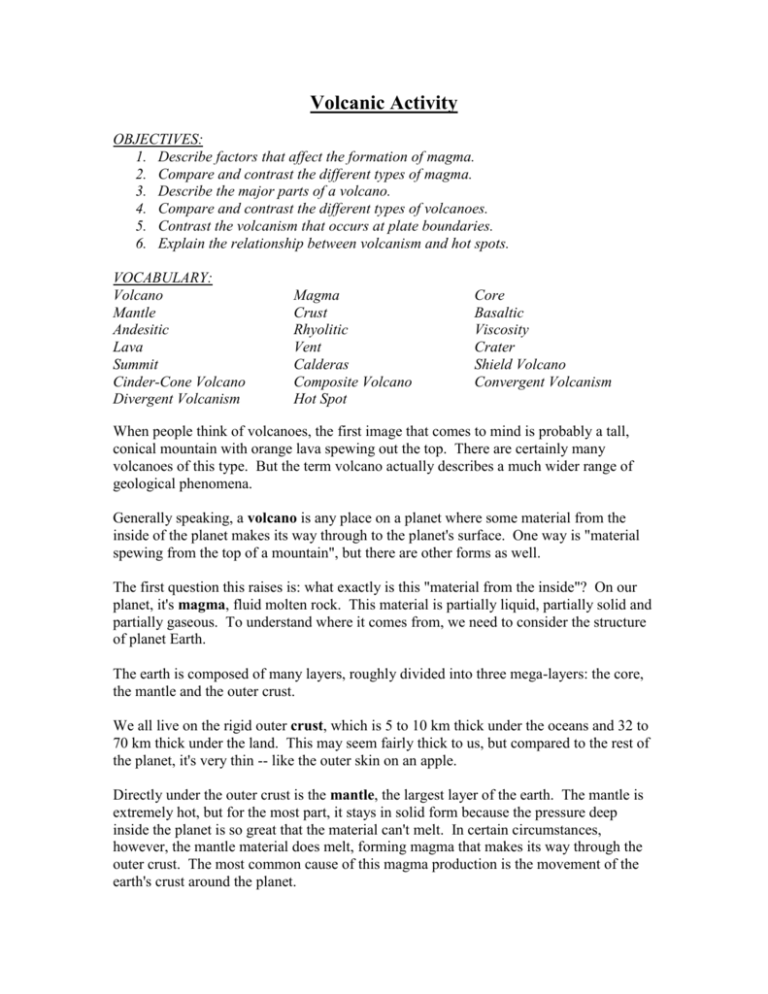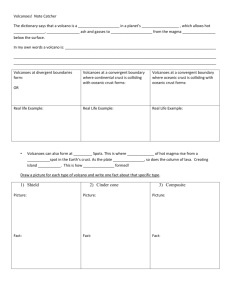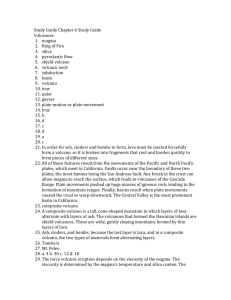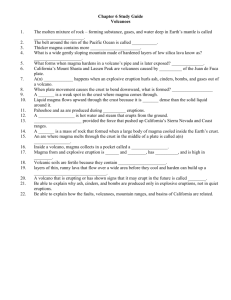Volcanic Activity
advertisement

Volcanic Activity OBJECTIVES: 1. Describe factors that affect the formation of magma. 2. Compare and contrast the different types of magma. 3. Describe the major parts of a volcano. 4. Compare and contrast the different types of volcanoes. 5. Contrast the volcanism that occurs at plate boundaries. 6. Explain the relationship between volcanism and hot spots. VOCABULARY: Volcano Mantle Andesitic Lava Summit Cinder-Cone Volcano Divergent Volcanism Magma Crust Rhyolitic Vent Calderas Composite Volcano Hot Spot Core Basaltic Viscosity Crater Shield Volcano Convergent Volcanism When people think of volcanoes, the first image that comes to mind is probably a tall, conical mountain with orange lava spewing out the top. There are certainly many volcanoes of this type. But the term volcano actually describes a much wider range of geological phenomena. Generally speaking, a volcano is any place on a planet where some material from the inside of the planet makes its way through to the planet's surface. One way is "material spewing from the top of a mountain", but there are other forms as well. The first question this raises is: what exactly is this "material from the inside"? On our planet, it's magma, fluid molten rock. This material is partially liquid, partially solid and partially gaseous. To understand where it comes from, we need to consider the structure of planet Earth. The earth is composed of many layers, roughly divided into three mega-layers: the core, the mantle and the outer crust. We all live on the rigid outer crust, which is 5 to 10 km thick under the oceans and 32 to 70 km thick under the land. This may seem fairly thick to us, but compared to the rest of the planet, it's very thin -- like the outer skin on an apple. Directly under the outer crust is the mantle, the largest layer of the earth. The mantle is extremely hot, but for the most part, it stays in solid form because the pressure deep inside the planet is so great that the material can't melt. In certain circumstances, however, the mantle material does melt, forming magma that makes its way through the outer crust. The most common cause of this magma production is the movement of the earth's crust around the planet. All volcanoes are fueled by magma deep beneath Earth’s surface. Magma is a mixture of molten rock, suspended mineral grains, and dissolved gases deep beneath Earth’s surface. Three factors work together to determan whether or not magma forms: o Temperatures are high enough to melt the rocks involved, between 800oC and 1200oC. o Pressure is low enough for the rock to melt. Pressure increases with depth because of the weight of the overlying rocks. As pressure increases, the temperature at which a substance melts also increases. o The pressence of water will change the melting point of a mineral. A wet mineral or rock will melt at a lower temperature than the same mineral or rock under dry conditions. There are three main types of magma: basaltic, andesitic, and rhyolitic. They differ in many ways. The main difference between them is the kind of rock they are composed of. Another difference is in their viscosity. Viscosity is how resistant the material is to flowing. Honey has a higher viscosity than water because it doesn’t flow as easily. Basaltic Magma o Forms when rocks in the upper mantel melt o Low viscosity allows it to rise rapidy to the Earth’s surface. o Contains small amounts of dissolved gases and silica, so the volcano erupts quietly. o Temperature between 1000oC and 1250oC Andesitic Magma o Found along continental margins o Intermediate viscosity because of a high silica content o The volcanoes have intermediate eruptions Rhyolitic Magma o Forms when molten material rises and mixes with the overlying silica and water rich continental crust. o High viscosity and large amounts of trapped gases cause the volcanoes to be very explosive. o Temperature between 700oC and 900oC When magma from the magma chamber reaches the Earth’s surface is is called lava. Lava erupts through an opening in the crust called a vent. As lava flows out on to the surface, it cools and solidifies around the vent. Over time, the lava can accumulate to form a mountain know as a volcano. At the top of a volcano, around the vent, is a bowlshaped depression called a crater. The crater is connected to the magma chamber by the vent. When the summit or the side of a volcano collapses into the magma chamber, a large depression called a calderas forms. Over time, these depressions fill in with water and form lakes at the top of the volcano. The appearance of a volcano depends on two factors: the type of material that forms the volcano and the type of eruptions that occur. Based on these two criteria, three major types of volcanoes have been identified and they differ in size, shape, and composition: o Shield Volcanoes A mountain with a broad, gently sloping sides and a nearly circular base. Form when layer upon layer of basaltic lava accumulates during nonexplosive eruptions. Ex. Hawaiian Islands o Cinder-Cone Volcanoes Steep sides and generally small, most less than 500 m high Form when material is ejected high into the air, falls back to Earth, and piles up around the vent o Composite Volcanoes Larger than cinder-cone volcanoes and the most dangerous Form when layers of volcanic fragments alternate with lava Ex. St. Helens The distribution of volcanoes on Earth’s surface is not random. 95% of volcanoes form at plate boundaries, with 5% occurs far from these boudaries. o Convergent Volcanism 80% of volcanoes are found here where tectonic plates come together. The underlying plate descend into the mantel and eventually melt, the magma is then forced upward through the overlying plate Found in two main areas on Earth – Circum-Pacific Belt (Rind of Fire) and the Mediterranean Belt. o Divergent Volcanism 15% of volcanoes are found here where tectonic plates are moving apart. Magma is forced upward into the fractures and faults that form as the plates separate, known as rift zones. Rift volcanism mainly occurs under water along ocean ridges. This can be seen above sea level in Iceland Some volcanoes are located far from plate boundaries. These volcanoes form as the result of hot spots, which are unusually hot regions of Earth’s mantle where hightemperature sections of mantel material rise toward the surface. They originate deep within the mantel where they melt rock that is then forced upward toward the surface as magma. The magma melts through the crust to form volcanoes. The hot spot remains stationary while the plate moves over it. The Hawaiian Islands is the location of one hot spot.






